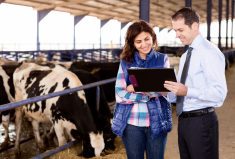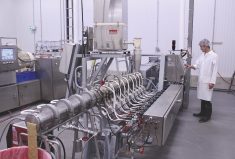It isn’t exactly unusual. Time and again, all across the country, and especially now with COVID-19, farmers have looked at what they produce and thought, “If only I could cut some distributors and wholesalers out of the chain, I’d get to keep a lot more of what the end-user actually pays for the food I grow. ”
The fly in the sticky trap is, you’re great at growing it. But who has a clue how to package the product, brand it, promote it or make those sales.
Read Also

Riding the tariff rollercoaster
Farmers are accustomed to roller-coaster years. But the current geopolitical windstorm is something else entirely. On his cattle operation near…
That was where farmers Rob and Charlotte Lepp started. They were great at production but didn’t really know much about marketing and promotion, so when they decided to establish their year-round, on-farm market to sell products from their farm and others close by, they decided early on that they would need some professional help.
It all began with a corn stand
Again, the way the story starts isn’t exactly unusual. It goes back to 1995, long before COVID-19, when the Lepps, like hundreds of Canadian farmers, first dipped a toe into direct marketing by selling sweet corn off the back of a trailer, later upgrading a corn stand at a site on their property near Abbotsford, B.C., which just happens to be at the intersection of a four-lane highway, so was a highly visible location.
Sweet corn seemed such a natural fit for their farm. As the province’s third-largest hog producer, they were already growing corn, and they were also looking to spread the manure across more acres. Plus, sweet corn would fit the family, creating jobs for their kids and their kids’ friends as they grew up.
After Rob’s dad retired in the early 2000s, the couple began thinking about ramping up the direct marketing side of things by creating a year-round market on the farm. It seemed like the perfect time to do it because Charlotte, an avid cook, was seeing the local food movement begin to develop. Now in their 40s, with their kids grown, the couple also had more time as well as more energy to devote to developing a new business.
“Chefs, cooking magazines and the cooking shows were talking more and more about local food, and we already loved the connection with the people we sold to,” says Charlotte. “We said, if we are going to change what we’re doing, because we had a couple of really bad years with the hog industry, we have to do it now before we get too old.”
Pencilling a plan
Initially envisioning just a larger produce stand, the couple were sketching plans for their new market on napkins for a couple of years, but it kept growing as they thought about adding more items.
“We’re livestock producers, so we thought why can’t we have a butcher shop in there as well,” says Charlotte. “Then we realized we wanted it to be more than just a little fruit and vegetable stand.”
They decided to cut back on hog production, raising just enough animals to provide pork for the market, which they finally built in 2009, a much larger, grander structure than they had originally planned that has prompted a lot of diversification of the farm to provide it with different products to sell.
The Lepps bought chicken quota and converted one of the old hog barns into a chicken barn. They bought cattle and started grazing them on a friend’s farm nearby and purchased a mixed orchard at Osoyoos in the Okanagan Valley. When their youngest son, Michael, joined the farm, they diversified further into strawberries, pumpkins, pickling cucumbers and beans, and last year added four acres of strawberry production under hoop houses.
What’s key is noticing trends and keeping up with what’s going on in the marketplace, says Charlotte, so this year they rented a greenhouse for hydroponic lettuce to serve their customers through the winter.
“We have all of the summer crops but we need income coming in all year-round,” says Charlotte. “So, we looked at what people are eating in the winter; they’re eating lots of salads and there’s more food safety issues with things like romaine coming in from California and Arizona, which was sort of another thing that we picked up on. This is something that we can grow here year-round and people eat a lot of it.”
Both Charlotte and Rob grew up on farms in the Abbotsford area. Rob’s father and uncle owned a road construction business and farmed on the side, but sold the business to get into hog farming in the 1970s. Charlotte’s parents came to Canada after the Second World War and bought a mixed farm growing raspberries and raising chickens. Charlotte and Rob eventually took over the farm from Rob’s dad and continued in hog production as they raised their three children Carrie, Michael and Jason. Michael now takes care of the farm operation, while Jason runs the butcher shop at the market.
Call in the professionals
Rob and Charlotte have high standards in everything they do, and they insisted that any marketing or advertising for the new market had to look good. “We knew that we didn’t know how to do that,” says Charlotte. “Starting up as a business, when we had absolutely zero retail experience other than our little corn stand, took so much energy we just couldn’t do everything.”
Someone they knew mentioned CREW Marketing Partners, a local company with offices in Vancouver and Kelowna, where founder Braden Douglas had deep roots in the food supply industries, having worked for large companies like Frito-Lay and Proctor & Gamble, and the Lepps decided to give them a try.

They feel now it was the right decision, even though it was a hard decision to make at a time when they had already sunk a lot of money into developing the market.
“It seemed like an incredibly big expense when there were already so many other expenses and people were already coming to the market, but as I said, you have to continually stay in front of them or they forget about you. They’re fickle and there are lots of options,” says Charlotte.
They were also finding that, all of a sudden, their message wasn’t as unique as it used to be.
“When we started, our tag line was “fresh from our farm to your place” and within five years, the grocery stores were all using a very similar message,” says Charlotte. “So, when the big grocery store is saying the same thing that you are, and they’re doing it at a cheaper price, you have to figure out what’s your value proposition now. What are we going to do differently? What do we offer that they don’t? And how do we tell people that, so that they continue to be willing to pay a little bit more than at the big chain grocery stores?”
So you see why the Lepp Farm Market tag line is now “Better When Shared.”
Stretch the marketing dollars
CREW also helped them stretch their marketing dollars to target the people most likely to become their customers.
“The marketing world is huge and big companies have big marketing budgets so we’re up against that, and we needed someone to say, this is the most efficient use of your dollars and to help us figure out what is our market. They helped us do customer surveys, and once we knew who our customer was looking to be, they helped us determine which postal codes in Abbotsford are our customers, based on household income and those kinds of things. Then they helped us design a mail-out, so rather than spending money and blanketing the whole city, we were able, with their help, to target potential customers, because you need to spend your money on people that are already kind of your people.”
With hundreds of marketing companies out there, what advice do the Lepps have to offer to help find the right one?
“Make sure they understand who you are,” says Charlotte. “Your marketing team has to get to know you because they are now your voice, which is really scary giving your voice over to somebody. What they do has to reflect who you are as a family, your values, your standing in the community. You have to take the time to find a marketing company that you feel comfortable with.”
Applying what they’ve learned
Those years working with CREW taught them a lot, and although they no longer engage a marketing company, they have hired two full-time people to work exclusively on advertising and promotion for Lepp Farm Market.
They use a lot of social media, particularly Instagram, which Charlotte says has now surpassed Facebook as the preferred digital tool, and they also send out a weekly email newsletter that includes Charlotte’s recipes and news about the farm and products at the market. The newsletter reaches around 10,000 subscribers and has a 28.8 per cent open rate, which is high.
Their focus continues to be promoting themselves as farmers, keying in on the burgeoning demand not just for locally grown food, but the desire to connect with the people growing it, something that has been ramped up even more during the COVID-19 pandemic as more people started preparing meals and eating at home.
“People love that it’s a family-owned business and in our Instagram stories, when I am talking about strawberries, I’m standing in the strawberry tunnels or I’ll be standing in the field with the corn planter behind me in May and say, ‘We’re planting the corn today that you will be eating this summer,’” says Charlotte. “It’s that personal touch that is resonating with people, and when they buy our products, they think of the Lepp family.”
But it’s important to keep delivering the messages consistently and often, says Charlotte.
“It’s just that same message over and over, this is grown on Lepp Farms, this is grown by our family, this is grown locally, and still, after 10 years, people that are regular customers will say, I didn’t know you raised the animals yourself, and you think, I have done nothing but talk about this for 10 years, how can you miss this message?” she says. “But you have to keep making it fresh, people get tone deaf really quickly, so you’ve got to stay on top of it, and we always give a personal answer on Facebook or Instagram if someone asks a question.”
No to online sales
The Lepp business model, like so many others, changed during COVID-19, as they launched an online purchasing option, and, after having to close their café, found themselves selling ready-prepared meals from the market’s kitchen. The online has dropped off and although it’s something they had been thinking about doing for a while, Charlotte says they know that their success is about the face-to-face relationships with the customers who walk through their door.
“We don’t want visitors just to drive through our parking lot, we want them to see the strawberry fields we just picked from,” says Charlotte. “You don’t see this stuff if you’re just clicking and buying carrots and lettuce.”
The Lepps’ other big focus is on providing exemplary customer service. “We have a high staff ratio, where we do things well so our products are naturally more expensive,” says Charlotte.
“We have a full butcher team, but with that, a customer can come to our market and say, can you cut this steak a certain way.”
Nothing makes Rob and Charlotte’s day better than a customer complimenting their staff and having an enjoyable shopping experience when they walk through the door.
They employ up to 100 people during peak times at the farm and market, keeping the market open seven days a week and running through an average of 800 transactions a day, although that number is higher in the summer.
Constantly evolving
It’s a busy life, but the promotion never stops and the Lepps have to constantly evolve to keep up with new trends, like mobile technology.
“We are revamping our website for the third time to be more mobile friendly because 70 per cent of our views are on a mobile device now,” says Charlotte.
Their advice to anyone looking to diversify their farm is to make sure you are promoting something you are passionate about, and to keep up with trends in food retail and food service.
“I’ve seen a lot of trends come and go already in the food world in these 10 years, but people wanting to connect with where their food is grown and the people who grow it, that is a trend that is not going away, it’s only gaining strength,” says Charlotte. “When you see all the big guys trying to do it, then you know you’re on to something and they can’t do it. You are the farmer, so you have something to offer that the big grocery stores cannot duplicate. ”
Don’t be scared to experiment, adds Charlotte, but know that the bottom line is you have to be profitable.
“What people want and what you can produce are often two different things,” Charlotte says. “People want strawberries that look like a picture in a magazine. They want them certified organic, and they want to buy them at Costco prices, and I tell people you can maybe have two of the three, but you can’t have all three. It’s impossible.”
Working with the public is not always easy and they constantly need to be educated about what you grow, says Charlotte. “Like every business owner, you have to be willing to put hard work into it, but if you’re a farmer, you have a great story and people want to hear that story, and you have to tell the story endlessly.”
















